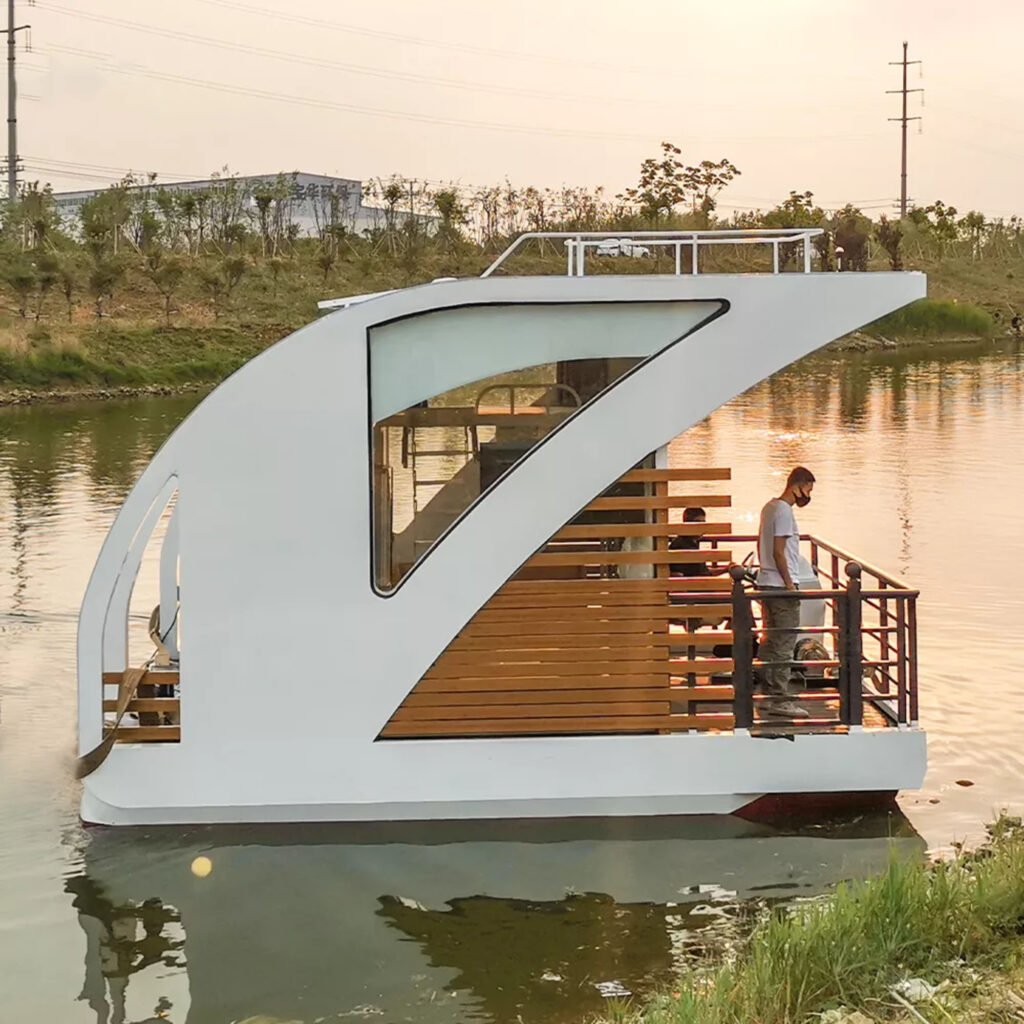Are you thinking of buying or constructing a floating home but wondering about its durability? You’re not the only one. A lot of folks enjoy the idea but are afraid of pouring their finances into something that would not endure. Swerve worrying.
With proper care, a floating house can last between thirty to fifty years, or even longer. This longevity is greatly influenced by starting with strong, high-quality materials, conducting regular checks, and addressing small issues promptly to prevent larger problems.
Floating homes have flexible design options that let you make changes to enhance durability. In this blog, we will discuss the lifespan of floating houses, what affects their durability, and how to ensure yours lasts for years.

1) Typical Lifespan of Floating House Components
Understanding the lifespan of a home’s different parts can be beneficial before picking a floating house. With proper maintenance and using the right kind of materials, the durability of the home can be improved.
i) Floats and Pontoons
First of all, the floats or pontoons are the base of your floating house. Concrete floats can outperform and outlast treated wood pontoons, which last around 20 to 30 years, by lasting more than 30 to 50 years. Pontoons made of treated wood last for about 20 to 30 years, which is comparatively less.

You can see that their lifespan is different depending on the materials used. On the other hand, steel or aluminum floats can last 30 to 40 years, 40 years at the maximum. However, they require additional maintenance to prevent rust or water damage.
ii) Deck Structural Design
Next, your floating home’s durability depends on the deck and main structure as well. If properly maintained, decks made of treated wood will last 15 to 25 years. Conversely, older materials usually last longer and are easier to maintain if you select aluminum decking, which is long-term, especially with a lifespan of over 30 years.

Likewise, a strong house structure constructed with steel or pressure-treated wood will stand the test of time as well.
iii) Mooring and Anchoring Systems
In addition, floating lodges are held in place using mooring and anchoring systems that consist of chains, anchors, as well as cables. These components have a lifespan of 15-25 years, influenced by ecological factors.

For example, saltwater can be particularly damaging. Therefore, it is important for you to monitor and check these systems. Avoiding bigger drift or damage problems can be done by timely replacement of parts.
2) Factors Influencing the Lifespan of Floating Houses
A floating home is able to support itself for quite a while, but this is only true under certain construction practices or care. What it is made of, its placement, and how you maintain it all make a big difference. Now we will discuss each of them one by one.
Materials for Construction and Quality
First of all, the house construction materials will greatly affect the house’s durability. Using treated wood, steel, aluminum, or even concrete will extend the durability of the house. For instance, marine-grade aluminum is corrosion resistant, and treated wood has good rot and insect resistance.

Thus, better materials will always help in extending the house life.
Types of Foundation and Design
Next, we discuss the base, or the foundation. Every house either floats on concrete, steel, or, in the case of some old models, logs. Floating on concrete is very strong for bases, especially steel, which lasts a long time if maintained and rust is taken care of. Conversely, logs are not as durable.
Therefore, selecting a suitable base guarantees that your home remains safe and strong for an extended period.
Environmental Conditions
You also have to think about what the water and weather conditions are like around the house. When compared to fresh water, salt water can cause damage more rapidly. Moreover, ice, storms, and strong waves can erode the building faster, too.

Extreme weather might also lead to rust, cracks, or mold growth. For that reason, the residents in such challenging areas use unusual resilient areas and make more inspections of the house.
Care and Maintenance
As important as the care of your house is, it’s the very last thing on people’s minds. You should manage to check floats, wood seals, and rust on metal surfaces. If you pursue these tasks regularly, you’ll get to see your house remain in good condition.
However, forgetting to do them might exacerbate the issues of leaking, breaking, or sinking of the house.
3) How to Maximize the Lifespan of a Floating House
With proper maintenance, a floating house can maintain its strength for many years. In this section, we will examine some practical tips to help your home last as long as possible.
Do Regular Checkups: Make sure to inspect your home regularly for issues. Look at the float, walls, ceilings, and any metallic components. Make inspections at least quarterly. If you resolve small issues during these home inspections, they will not escalate to become larger, more expensive issues later.

Protect It from Weather: Your home should be protected from rain, sunlight, and even salty water. To prevent wood from decomposing and metal from rusting, use specific paints or coatings. Adding waterproof coverings is another option, along with sealing all the cracks so water cannot seep in.
Replace Worn-Out Floats on Time: Pay attention to the floats underneath your house. If they are beginning to wear or crack, replacing them immediately is critical. Putting this off for an extended time can cause a house to sink. New floats assist in stabilizing the house.
Clean the Outside Often: One more good thing to do is to clean the outside of your house. Salt, algae, and dirt can accumulate. Removing these will protect the home’s surface and also improve the appearance of the house.
Keep Records of Repairs: Most importantly, document all repairs done and any new parts added. This helps in the memory of the steps taken and what remains to be checked next. In case you plan to sell the house, this information will greatly assist.
4) Signs Your Floating House Needs Big Repairs or a Replacement
Although you make sure to maintain your floating house, there comes a time when it will require major repairs. Let me share a few signs that indicate problems to look out for.

The House Starts to Lean: The first thing to note is that the float systems underneath the house are likely broken if the house is tilting or feels uneven. A house that is leaning means that something supporting it is malfunctioning, and repairs must be made immediately if it is to be fixed.
Cracks in the Floats: Next, check for any fissures on the float or base. Even minor ones can expand and allow water inside, compromising the structure and leading to potential sinking or hazard risks for the house.
Big Water Damage: Furthermore, spotting moist areas, soft walls and floors, as well as mold, indicates leakage. Excess internal water can lead to significant structural damage and even cause rot.
Always Fixing Something: Lastly, if you notice that you are always fixing something or spending money to ensure the house is safe, then perhaps you should consider replacing old parts or even the entire house.
5) Is a Floating House Worth the Money?
Before investing in a floating house, it is vital to ask the question, How long will it last? Here, we will analyze the cost vs. lifespan ratio as well as compare it with other types of homes.
Factor | What to Know |
Upfront Cost vs. Long-Term Value | Floating houses can cost more at the start, but they last many years with good care. |
Compared to Houseboats or Traditional Housing | They often last longer than houseboats and may cost less over time than land homes. |
Insurance and Mooring Costs | Extra costs like insurance and docking fees should also be included in your budget. |
Dr. Jonathan Fellus from Quora said that Mal de Debarquement Syndrome is usually acquired after a boat or vessel trip and can last for weeks, months, years, or even permanently. In contrast, Floating Harbor Syndrome is a rare genetic disorder that lasts a lifetime. He explained that both conditions are rare, but the genetic one is even rarer.

Conclusion
In short, taking proper care of your floating house ensures it lasts between thirty to fifty years, if not longer. Always start by using strong materials. Regular checks and prompt repairs to address small issues prevent bigger issues. Always look for signs of damage.
If you do the things we discussed will protect your home for many years. Here at Space Capsule House, we offer enduring floating houses. Reach out today to learn more!


